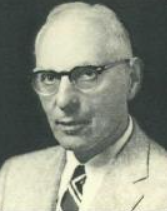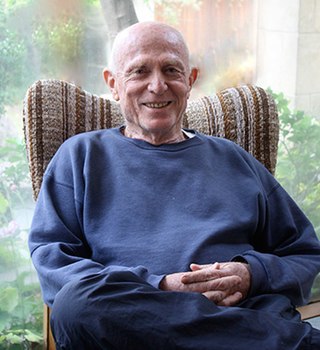
Milton Hyland Erickson was an American psychiatrist and psychologist specializing in medical hypnosis and family therapy. He was the founding president of the American Society for Clinical Hypnosis. He is noted for his approach to the unconscious mind as creative and solution-generating. He is also noted for influencing brief therapy, strategic family therapy, family systems therapy, solution focused brief therapy, and neuro-linguistic programming.
Clinical psychology is an integration of human science, behavioral science, theory, and clinical knowledge for the purpose of understanding, preventing, and relieving psychologically-based distress or dysfunction and to promote subjective well-being and personal development. Central to its practice are psychological assessment, clinical formulation, and psychotherapy, although clinical psychologists also engage in research, teaching, consultation, forensic testimony, and program development and administration. In many countries, clinical psychology is a regulated mental health profession.

Craniosacral therapy (CST) or cranial osteopathy is a form of alternative medicine that uses gentle touch to feel non-existent rhythmic movements of the skull's bones and supposedly adjust the immovable joints of the skull to achieve a therapeutic result. CST is a pseudoscience and its practice has been characterized as quackery. It is based on fundamental misconceptions about the anatomy and physiology of the human skull and is promoted as a cure-all for a variety of health conditions.
Psychological trauma is an emotional response caused by severe distressing events that are outside the normal range of human experiences. It must be understood by the affected person as directly threatening the affected person or their loved ones with death, severe bodily injury, or sexual violence; indirect exposure, such as from watching television news, may be extremely distressing and can produce an involuntary and possibly overwhelming physiological stress response, but does not produce trauma per se. Examples include violence, rape, or a terrorist attack.

Max Gerson was a German-born American physician who developed the Gerson Therapy, a dietary-based alternative cancer treatment that he claimed could cure cancer and most chronic, degenerative diseases.
Solution-focused (brief) therapy (SFBT) is a goal-directed collaborative approach to psychotherapeutic change that is conducted through direct observation of clients' responses to a series of precisely constructed questions. Based upon social constructivist thinking and Wittgensteinian philosophy, SFBT focuses on addressing what clients want to achieve without exploring the history and provenance of problem(s). SF therapy sessions typically focus on the present and future, focusing on the past only to the degree necessary for communicating empathy and accurate understanding of the client's concerns.
Murray Bowen was an American psychiatrist and a professor in psychiatry at Georgetown University. Bowen was among the pioneers of family therapy and a noted founder of systemic therapy. Beginning in the 1950s he developed a systems theory of the family.
Complex post-traumatic stress disorder is a stress-related mental disorder generally occurring in response to complex traumas, i.e., commonly prolonged or repetitive exposures to a series of traumatic events, within which individuals perceive little or no chance to escape.
Contingency management (CM) is the application of the three-term contingency, which uses stimulus control and consequences to change behavior. CM originally derived from the science of applied behavior analysis (ABA), but it is sometimes implemented from a cognitive-behavior therapy (CBT) framework as well.
Triangulation is a term in psychology most closely associated with the work of Murray Bowen known as family therapy. Bowen theorized that a two-person emotional system is unstable, in that under stress it forms itself into a three-person system or triangle.
A clinical formulation, also known as case formulation and problem formulation, is a theoretically-based explanation or conceptualisation of the information obtained from a clinical assessment. It offers a hypothesis about the cause and nature of the presenting problems and is considered an adjunct or alternative approach to the more categorical approach of psychiatric diagnosis. In clinical practice, formulations are used to communicate a hypothesis and provide framework for developing the most suitable treatment approach. It is most commonly used by clinical psychologists and is deemed to be a core component of that profession. Mental health nurses, social workers, and some psychiatrists may also use formulations.
Ivan Boszormenyi-Nagy was a Hungarian-American psychiatrist and one of the founders of the field of family therapy. Born Iván Nagy, his family name was changed to Böszörményi-Nagy during his childhood. He emigrated from Hungary to the United States in 1950, and he simplified his name to Ivan Boszormenyi-Nagy at the time of his naturalization as a US citizen.
Common factors theory, a theory guiding some research in clinical psychology and counseling psychology, proposes that different approaches and evidence-based practices in psychotherapy and counseling share common factors that account for much of the effectiveness of a psychological treatment. This is in contrast to the view that the effectiveness of psychotherapy and counseling is best explained by specific or unique factors that are suited to treatment of particular problems.
Gerald R. Weeks is an American author and lecturer. He has published 30 books on psychotherapy, which have been translated into multiple languages. He has published in the fields of individual, and family therapy, although he is best known for his work in sex and couple's therapy. Weeks is the founder of the Systems Approach to Sex Therapy as well as the founder of the Intersystem Approach to therapy which has been called one of the most ambitious efforts to develop an integrative approach to psychotherapy. He was a professor in the Marriage and Family Therapy Program at the University of Nevada-Las Vegas from 1999-2017. In 2017, he became Professor Emeritus as he retired from UNLV.
Family therapy is a branch of psychotherapy focused on families and couples in intimate relationships to nurture change and development. It tends to view change in terms of the systems of interaction between family members.
A culturagram is a family assessment tool used in the practice of social work which was first introduced by Fordham University professor, Dr. Elaine Congress.

Moshe Lang is an Australian family therapist, clinical psychologist (MAPS) and author. Born in Israel, Lang migrated to Australia as a young man and settled there in 1961. He is one of the pioneers of family therapy in Australia; one of the nation's best known family therapists. Lang has published and taught extensively in his professional area, both in Australia and worldwide.
Froma Walsh is an American clinical psychologist and family therapist. She is the co-founder and co-director of the Chicago Center for Family Health and the Mose and Sylvia Firestone Professor Emerita at the University of Chicago.
The dynamic-maturational model of attachment and adaptation (DMM) is a biopsychosocial model describing the effect attachment relationships can have on human development and functioning. It is especially focused on the effects of relationships between children and parents and between reproductive couples. It developed initially from attachment theory as developed by John Bowlby and Mary Ainsworth, and incorporated many other theories into a comprehensive model of adaptation to life's many dangers. The DMM was initially created by developmental psychologist Patricia McKinsey Crittenden and her colleagues including David DiLalla, Angelika Claussen, Andrea Landini, Steve Farnfield, and Susan Spieker.
Systemic hypothesising is a branch of psychology and Systemic therapy that works with behaviour practitioners and other allied health professionals to reflect upon the interpersonal and relational dynamics that may be inhibiting positive behaviour change efforts in people with an intellectual disability or other neurodiverse conditions.




